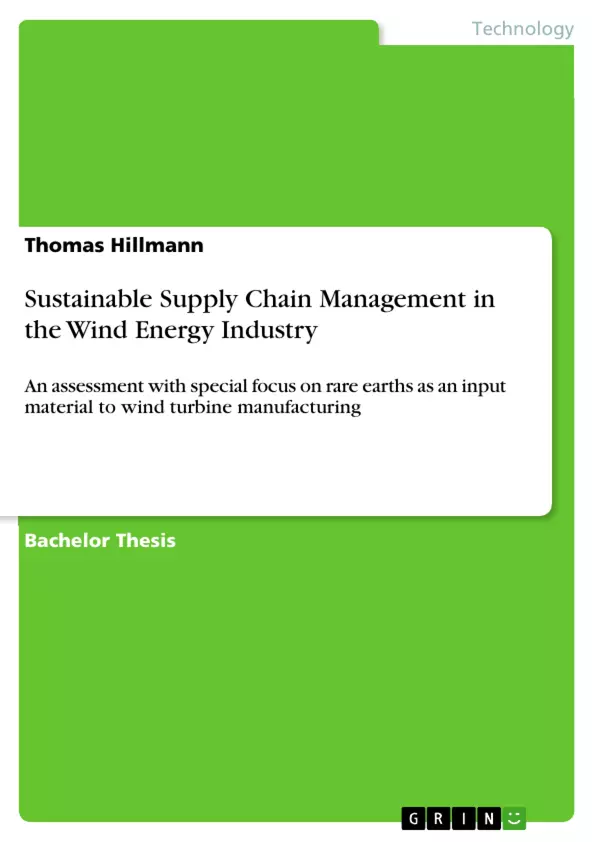This paper takes into account various effects the use of wind energy has on different levels of the environment. The most promising benefits and pressing challenges will be presented to allow for a differentiated assessment of the sustainability performance of wind energy as a power source. This will also be done in comparison to other forms of energy generation both fossil and renewable ones.
From supply chain perspective, the paper will focus on the supply of rare earths as an input material to wind turbine manufacturing. The reasons for which this is to be considered the most questionable aspect of the supply chain will be explained as well as solutions proposed for how effective supply chain management can help improve the situation.
Inhaltsverzeichnis (Table of Contents)
- Introduction
- Background motivation and aim of the paper
- Scope of the assessment
- Structure of the paper
- Sustainability in Supply Chain Management – Literature review
- Definitions of sustainability
- Motives for sustainable conduct in business
- Sustainability from supply chain perspective
- The wind energy industry – Case study
- Overview of global wind energy industry
- Functionality of a wind turbine
- Sustainability in the wind energy industry – Analysis
- Benefits of wind energy
- CO2-emissions reduction
- Stable energy prices and bigger autonomy in the long-run
- Decentralisation of energy production
- Advantages of new PMG technology over DFIG
- Negative aspects about wind energy
- Rare earths mining
- Definition of rare earths and their economic use
- Supply of rare earths
- Ecologic and social harm caused by mining in China
- Increased need for backup capacity
- Increased bird mortality due to wind parks
- Assessment of sustainability performance
- Economic sustainability
- Social sustainability
- Ecologic sustainability
- Possible solutions to the REE dilemma
- Reduced use of rare earths
- Closed-loop supply chains for permanent magnets
- Biomining of REE
- Summary and Conclusion
Zielsetzung und Themenschwerpunkte (Objectives and Key Themes)
This thesis aims to assess the sustainability performance of the global wind energy industry. The assessment is based on an end-to-end supply chain perspective, with a focus on the use of rare earths as an input material to wind turbine manufacturing. The thesis highlights both the benefits and challenges of wind energy, and investigates the sustainability performance of the industry in terms of economic, social, and environmental factors.
- Sustainability in Supply Chain Management
- The global wind energy industry
- The impact of rare earth mining on wind turbine manufacturing
- The sustainability performance of wind energy
- Potential solutions to address the challenges posed by rare earth dependence
Zusammenfassung der Kapitel (Chapter Summaries)
The introduction presents the motivation for the thesis, defines the scope of the assessment, and outlines the structure of the paper. Chapter 2 reviews relevant literature on sustainability in supply chain management, covering key definitions, motives for sustainable business practices, and a supply chain perspective on sustainability. Chapter 3 examines the wind energy industry as a case study, providing an overview of the global market and the functionality of wind turbines. Chapter 4 analyzes the sustainability of the wind energy industry, exploring both the benefits and challenges, including the environmental and social impacts of rare earth mining.
Chapter 5 focuses on potential solutions to address the challenges posed by rare earth dependence, examining options such as reducing rare earth usage, implementing closed-loop supply chains, and exploring alternative extraction methods like biomining. The thesis concludes with a summary and a discussion of key findings.
Schlüsselwörter (Keywords)
The key themes of the thesis include sustainable supply chain management, wind energy, rare earth elements, environmental sustainability, social sustainability, and economic sustainability. The work examines the complex relationship between these concepts, focusing on the challenges and opportunities related to rare earth mining and their impact on the overall sustainability of the wind energy industry.
- Citation du texte
- Thomas Hillmann (Auteur), 2015, Sustainable Supply Chain Management in the Wind Energy Industry, Munich, GRIN Verlag, https://www.grin.com/document/455543



